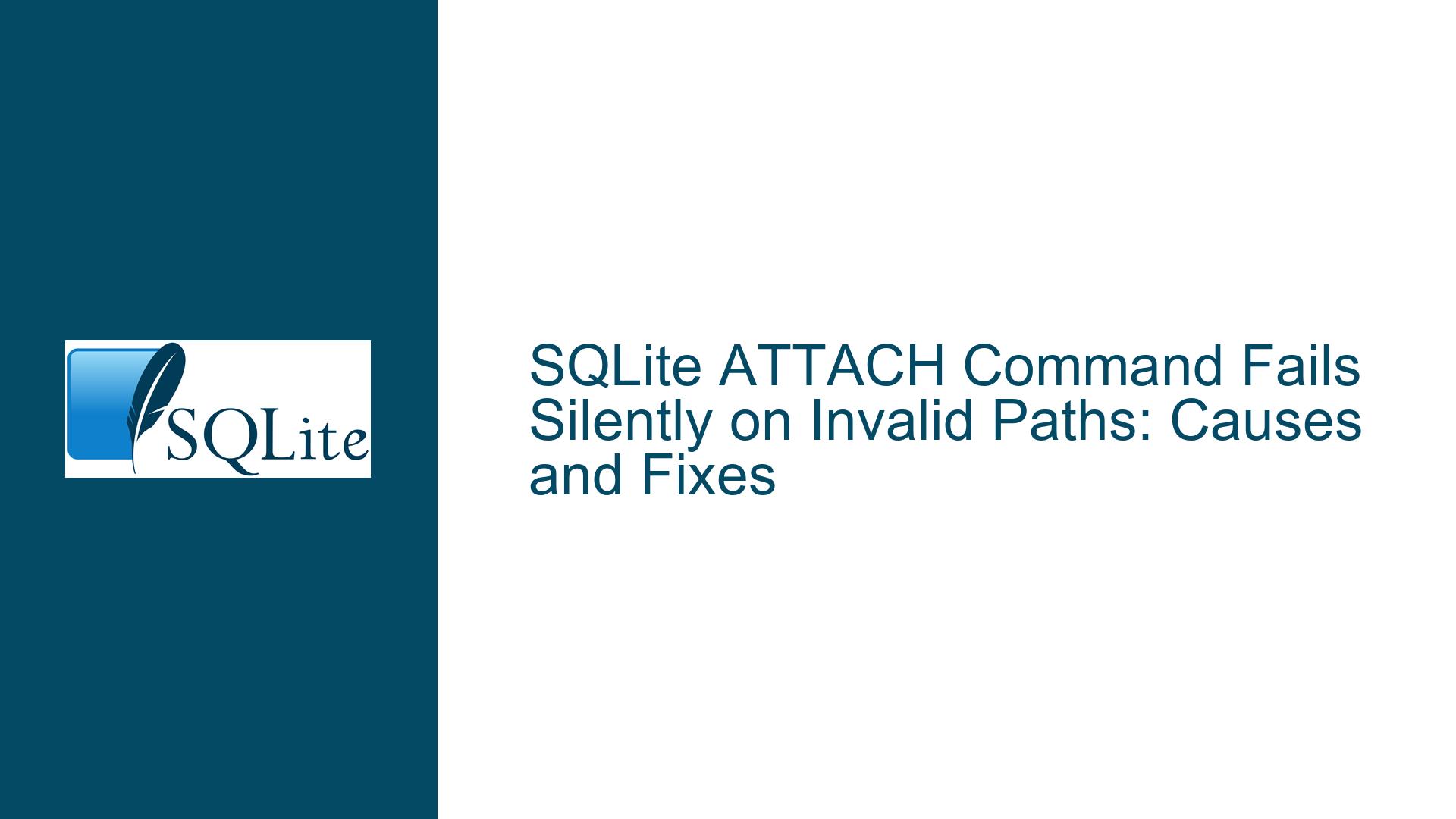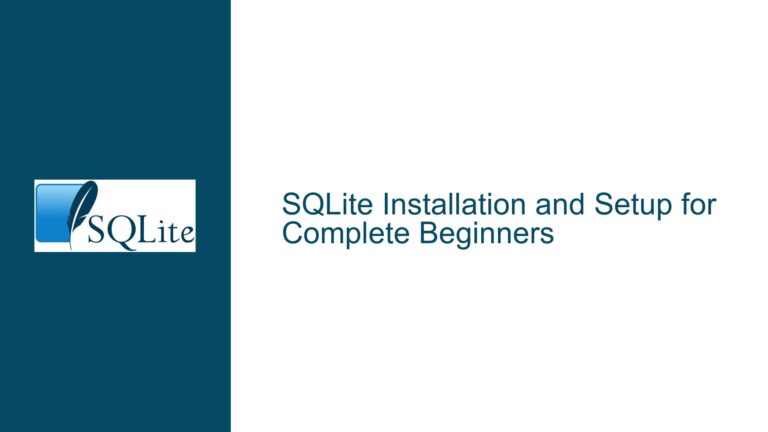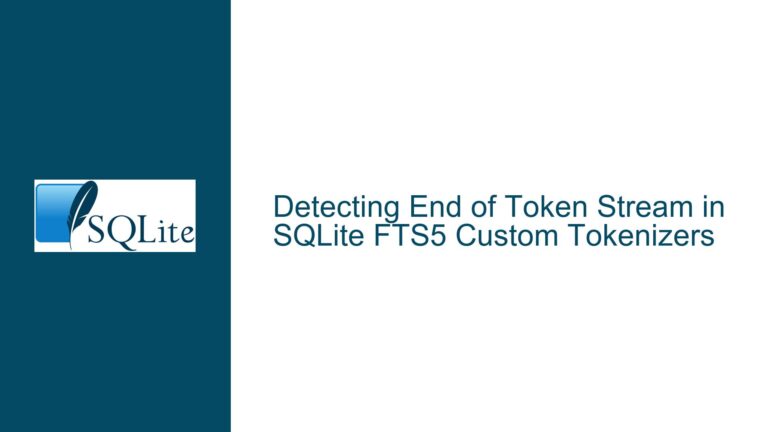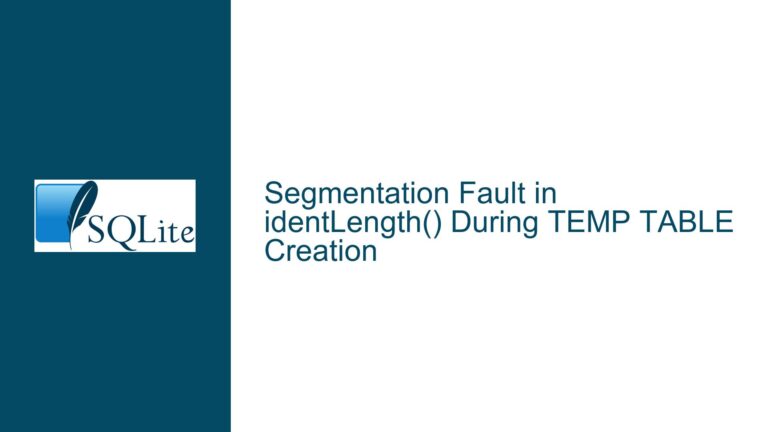SQLite ATTACH Command Fails Silently on Invalid Paths: Causes and Fixes
Issue Overview: Silent Failure in SQLite ATTACH Command with Invalid Paths
The SQLite ATTACH command is a powerful feature that allows users to attach an external database file to the current database connection. This enables queries to span multiple databases, making it a useful tool for complex data management tasks. However, a significant issue arises when the ATTACH command is used with an invalid or nonexistent file path. Instead of immediately raising an error, SQLite silently accepts the command and only fails when a subsequent query is executed against the attached database. This behavior can lead to confusion, delayed error detection, and debugging challenges, especially in larger applications where the failure might not be immediately apparent.
The core of the problem lies in SQLite’s default behavior when handling file paths. By design, SQLite attempts to create a new database file if the specified file does not exist. This auto-creation feature is convenient in many scenarios but becomes problematic when the file path is invalid or inaccessible. In such cases, the ATTACH command does not fail outright but defers the error until the attached database is accessed. This deferred failure can obscure the root cause of the issue, making it harder for developers to diagnose and resolve the problem.
The discussion highlights the importance of immediate error detection in software systems. When a command like ATTACH fails silently, it violates the principle of failing visibly or detectably, which is crucial for maintaining robust and maintainable code. The lack of immediate feedback can lead to subtle bugs that are difficult to trace, especially in applications where database operations are spread across multiple modules or layers.
Possible Causes: Why SQLite Defers Errors in ATTACH Command
The deferred error behavior in the ATTACH command can be attributed to several factors, including SQLite’s file handling mechanisms, the default flags used during database connections, and the interaction between connection-level and attachment-level settings. Understanding these factors is essential for diagnosing and addressing the issue effectively.
1. Auto-Creation of Database Files
One of the primary reasons for the deferred error is SQLite’s auto-creation feature. When a database file specified in the ATTACH command does not exist, SQLite attempts to create it automatically. This behavior is controlled by the SQLITE_OPEN_CREATE flag, which is often enabled by default in many applications. If the file path is invalid or the application lacks the necessary permissions to create the file, the ATTACH command does not fail immediately. Instead, the error is deferred until the application attempts to access the attached database.
2. Connection-Level vs. Attachment-Level Flags
SQLite’s handling of file paths and flags is influenced by the distinction between connection-level and attachment-level settings. When a connection is established using sqlite3_open or a similar function, default flags such as SQLITE_OPEN_READWRITE and SQLITE_OPEN_CREATE are applied to the connection. These flags determine how the main database and any attached databases are handled. However, the ATTACH command inherits these connection-level flags unless overridden by URI-based file naming or other mechanisms. This inheritance can lead to unexpected behavior, especially when the connection-level flags are not aligned with the intended behavior for attached databases.
3. URI File Naming and Flag Overrides
URI file naming provides a way to specify additional options when opening or attaching a database. For example, the mode=ro option can be used to open a database in read-only mode, while mode=rwc allows read-write access and auto-creation of the file if it does not exist. However, the interaction between URI-based options and connection-level flags can be complex. In some cases, the URI-based options may not override the connection-level flags as expected, leading to inconsistent behavior. This complexity can contribute to the deferred error issue, as the ATTACH command may not enforce the intended restrictions on file creation or access.
4. Limitations in Error Handling
SQLite’s error handling mechanisms are designed to be lightweight and efficient, which is one of the reasons for its widespread use in embedded systems and applications with limited resources. However, this design philosophy can sometimes result in less immediate or less detailed error reporting. In the case of the ATTACH command, the library defers certain checks until the database is accessed, which can make it harder to detect and diagnose issues early in the execution flow.
Troubleshooting Steps, Solutions & Fixes: Addressing Silent Failures in ATTACH Command
To address the silent failure issue in the ATTACH command, developers can take several steps to ensure that errors are detected and handled appropriately. These steps include modifying the way database connections are established, using URI-based file naming to enforce specific behaviors, and implementing custom error-checking mechanisms. Below, we explore these solutions in detail.
1. Disabling Auto-Creation with URI File Naming
One of the most effective ways to prevent silent failures is to disable the auto-creation of database files when using the ATTACH command. This can be achieved by using URI-based file naming with the mode=rw option, which specifies read-write access without auto-creation. For example:
ATTACH 'file:/nonexistent/path/to/db?mode=rw' AS ext;
This approach ensures that the ATTACH command fails immediately if the specified file does not exist, rather than attempting to create it. By explicitly disabling auto-creation, developers can avoid the deferred error issue and ensure that problems are detected early in the execution flow.
2. Overriding Connection-Level Flags
In some cases, the connection-level flags may not align with the intended behavior for attached databases. To address this, developers can use URI-based file naming to override the connection-level flags for specific attachments. For example:
ATTACH 'file:/path/to/db?mode=ro' AS ext;
This command attaches the database in read-only mode, regardless of the connection-level flags. By using URI-based options to enforce specific behaviors, developers can ensure that the ATTACH command behaves as expected and fails immediately if the specified conditions are not met.
3. Implementing Custom Error Checking
In addition to using URI-based file naming, developers can implement custom error-checking mechanisms to detect and handle issues with the ATTACH command. For example, before executing the ATTACH command, the application can check whether the specified file exists and is accessible. This can be done using platform-specific file system APIs or a simple SQL query:
SELECT * FROM pragma_database_list WHERE name = 'ext';
If the query returns no results, it indicates that the attachment was not successful, and the application can raise an appropriate error. By combining custom error checking with URI-based file naming, developers can create a robust solution that prevents silent failures and ensures that errors are detected and handled appropriately.
4. Applying Patches to Modify Default Behavior
For advanced users, modifying the SQLite source code may be an option to address the deferred error issue. The discussion includes a rudimentary patch that modifies the behavior of the sqlite3_open function to allow URI-based mode overrides. While this approach can provide a more immediate solution, it requires careful consideration and testing to ensure that it does not introduce new issues. Developers should thoroughly analyze the impact of any patches and consider the trade-offs between immediate error detection and potential side effects.
5. Best Practices for Database Management
Finally, adopting best practices for database management can help prevent issues related to the ATTACH command. These practices include:
- Validating file paths and permissions before executing database operations.
- Using consistent naming conventions and file locations to minimize the risk of invalid paths.
- Implementing comprehensive error handling and logging mechanisms to detect and diagnose issues early.
- Regularly reviewing and testing database-related code to ensure that it behaves as expected under various conditions.
By following these best practices, developers can reduce the likelihood of encountering silent failures and ensure that their applications are robust, maintainable, and reliable.
Conclusion
The silent failure issue in SQLite’s ATTACH command is a nuanced problem that stems from the library’s default behavior and the interaction between connection-level and attachment-level settings. By understanding the underlying causes and implementing the appropriate solutions, developers can address this issue effectively and ensure that errors are detected and handled appropriately. Whether through URI-based file naming, custom error checking, or source code modifications, there are multiple approaches to resolving the deferred error problem and improving the reliability of database operations in SQLite.






